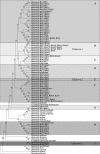Prevalence and genetic diversity of Bartonella spp. in small mammals from Southeastern Asia
- PMID: 22983968
- PMCID: PMC3497379
- DOI: 10.1128/AEM.02008-12
Prevalence and genetic diversity of Bartonella spp. in small mammals from Southeastern Asia
Abstract
Among 1,341 blood samples from rodents that were trapped in Southeast Asia between 2008 and 2010, we found a prevalence of Bartonella infection ranging from 9.6 to 11.9%. Bartonella species identified (143 isolates) included B. elizabethae, B. coopersplainsensis, B. phoceensis, B. queenslandensis, B. rattimassiliensis, B. tribocorum, and three new putative Bartonella species.
Figures


References
-
- Bai HM, Yang FL, Yang H, Zhang Q. 2005. Study on Bartonella species in rodents in western Yunnan, China. Zhonghua Liu Xing Bing Xue Za Zhi 26:868–870 (In Chinese.) - PubMed
-
- Bai Y, Kosoy MY, Lerdthusnee K, Peruski LF, Richardson JH. 2009. Prevalence and genetic heterogeneity of Bartonella strains cultured from rodents from 17 provinces in Thailand. Am. J. Trop. Med. Hyg. 81:811–816 - PubMed
Publication types
MeSH terms
Substances
Associated data
- Actions
- Actions
- Actions
- Actions
- Actions
- Actions
- Actions
- Actions
- Actions
- Actions
- Actions
- Actions
- Actions
- Actions
- Actions
- Actions
- Actions
- Actions
LinkOut - more resources
Full Text Sources
Miscellaneous

